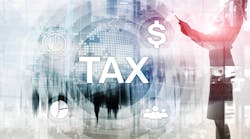It’s that time of year for thinking about taxes, and how not to pay so much for 2022. Planning your investments this year, as you move from a human workflow to an all-digital transformation in your office with front- and back-office automation, will help you do what you do best—dentistry. Yes, I said it. All-digital transformation of your dental office is happening, as you are moving from analog to all-digital all the time to make your office more productive.
The cloud has become important in dental practices over the last decade, but did you know that Tax Code 179 not only applies to equipment and hardware, but also to cloud-based software and SaaS investments? With the advancement of technology, software is integral to many products, both for dental and administrative purposes.
Sorting through the vast amount of software available to find what is right for your office is the hardest part. For starters, you might try Capterra to find, sort, and filter available dental software to see what products might best fit your needs by type, pricing, and products. Talk to an expert if you want even more information about choosing software.
You might hear a new term, Software as a Medical Device (SaMD), which is just software to run your dental office devices. (Is this another way to say the Internet of Things?) Its official definition is “software intended to be used for one or more medical purposes that perform these functions without being part of a hardware medical device.” Two other types of software also exist. One is software within a dental/medical device. Another is software that is used to keep equipment up to date, like you do for printer software.
Related reading:
- Data management: Time for dental practices to catch up
- Cloud-based practice management systems: The view is worth the climb
Many software purchases come with a time-limited contract, in which you may or may not own the data. Make sure you own your own data. In looking at these cloud software contracts, you will want to consider a variety of factors. What is the purpose of the software, and how is it used? How often is it updated? Is there a service contract or contract period for use of the software? Are updates provided for a cost, or are they free? Do your due diligence, just as you would for any dental product.
Other considerations include questions such as: Is the software embedded in a device, with your rights to access on the cloud, or is there a standard software licensing fee that includes periodic storage on your own storage systems? Does the software integrate with your other systems? Is training on the software for you and your staff part of the service contract? Finally, there should always be an end date for any software contract, as well as defined security methods to store or download data for retrieval. The privacy and security of your data needs to be assured. More on that later in this article.
In my opinion, here are the top five cloud-based technology investments to consider this year for automating necessary paperwork and everyday computing tasks for the dental practice that we all love to hate.
1. Front office automation: Appointments, reminders, and fill-in schedule for Dentrix users
If you have ever gone home thinking that your staff made more than you did that day, then this is the software to increase your productivity. There’s no need to task the front desk with recall visits, as this program automatically contacts patients for this service and also sends appointment reminders with confirmations to your office. You can opt for reminder messaging or cancellation fill-ins for filling gaps from last-minute schedule changes. This also can be used in multiple locations.
2. Front office automation for EagleSoft users
Similar to Lighthouse for EagleSoft users, this front desk automation software offers many of the same features as above, including portability with an internet connection. With this cloud-based system, you can manage multiple types of practice data and have everything in one place. This is an easy-to-use program, with dashboards to assess your performance, your patient’s needs, and a way to match these to maximize productivity with in-office chair time.
3. Dental inventory
If you have ever had a patient in the chair and been without the proper supplies or materials, this program is for you. While it does work on cancellations and reminders, its main benefit is managing your dental inventory and supplies, shopping for the right product, and making sure it is on hand when you need it.
Dentsoftware is both a dental inventory management and organizational management software. While it can perform for clinic management such as appointments, reminders, and files, inventory management is its best functionality, including tracking, ordering, and vendor relations.
You can also customize your recurring orders. An inventory template can be loaded on any device, like a smartphone, on the cloud-based system. Financial tracking, auditing capabilities, and communication about those inevitable supply shortfalls are included. Practicedent is a similar program and good for multiple dental offices.
4. In-house dental membership program
Let’s face it, dental insurance is not like medical insurance, which pays for catastrophic events. Rather, dental insurance is a discount program on your services, with third-party payers sharing data on this. I call it Groupon for dental care. Both patients and dentists are discouraged by the hurdles in preapprovals, claim submissions, and reimbursements.
Why not offer a discount program yourself to patients who do not have insurance? Track them with Boomcloud. With this program, you can increase the portion of your practice that is fee-for-service and enroll enough patients to generate stable revenue for your practice.
This service offers a cloud-based software program to create, organize, track, and automate an in-house membership program. Instead of constantly being moved in and out of plans based on some actuary at an insurance company, you can create a customized plan to enroll patients from your website.
Since many DSOs offer these, private practices can now be competitive for this service. This intuitive program keeps track of payments, organizes members, and tracks key performance indicators (KPIs) in an easy-to-use dashboard.
5. Back-office billing software
Looking for reliability in your revenue stream? Vyne Trellis, a web-based dental billing platform, facilitates the vicissitudes of billing, including secure exchange of encrypted health information and determining real-time eligibility of patient benefit coverage.
Don’t forget that software and security issues go hand and hand. I like Black Talon to help with going one step beyond cybersecurity to protect your business from ransomware, track intrusions, and address any ransomware attacks. I worry about ransomware, as this can be both costly and can keep your practice from operating, so prevention is very important.
This group understands the world of dentistry and the need for privacy and security of our patient records, planning ways to avoid ransomware attacks that are becoming more frequent in dentistry. While they are not the local tech guy or multiservice provider who addresses your in-office computers, they work with you and your local computer service to assure that you always have security and backups in the cloud, where you need it, protecting your practice from those hackers. Hackers are using the dark web to see private medical information about patients, so avoid this problem with prevention.
With these front- and back-office automations in the cloud and security, you can smile and do what you do best—dentistry. Instead of wrangling with cumbersome billing and the vagaries of dental reimbursement for services or worrying about ransomware attacks, you can take control of your business with a cloud-based solution to your headaches. Plus, when it comes tax time next year, you may have more to smile about for you and your patients. With these new software products, you’ll have more time to provide dental care, with less worry and greater productivity.
Editor's note: This article appeared in the March 2022 print edition of Dental Economics. Dentists in North America are eligible for a complimentary print subscription. Sign up here.







